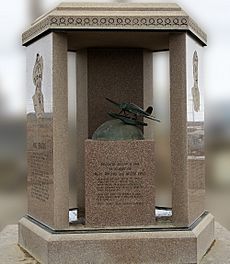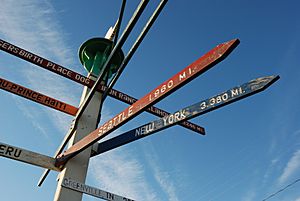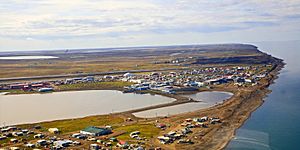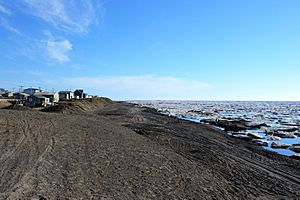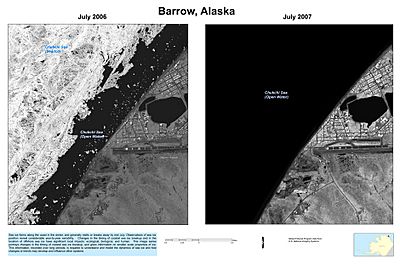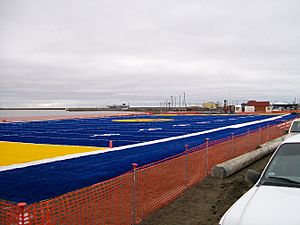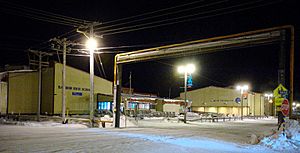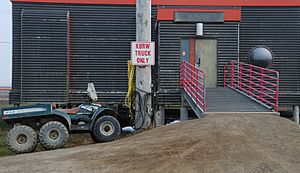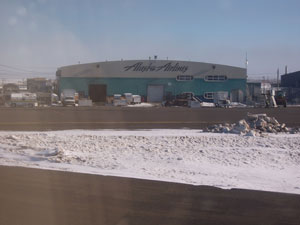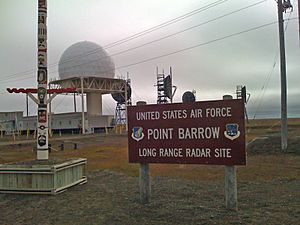Utqiagvik, Alaska facts for kids
Quick facts for kids
Utqiagvik
|
||
|---|---|---|
| City of Utqiaġvik | ||
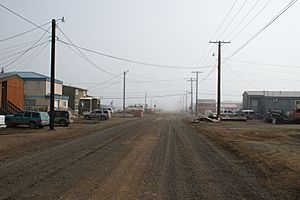
Street view of Utqiagvik in July 2008. Like all the others in Utqiagvik, this street has been left unpaved due to the prevalence of permafrost.
|
||
|
||
| Motto(s):
The Northernmost American City
|
||
| Country | United States | |
| State | Alaska | |
| Borough | North Slope | |
| Incorporated | June 8, 1959 | |
| Area | ||
| • Total | 21.48 sq mi (55.63 km2) | |
| • Land | 18.77 sq mi (48.61 km2) | |
| • Water | 2.71 sq mi (7.01 km2) | |
| Elevation | 10 ft (3 m) | |
| Population
(2020)
|
||
| • Total | 4,927 | |
| • Density | 262.49/sq mi (101.35/km2) | |
| Time zone | UTC−09:00 (AKST) | |
| • Summer (DST) | UTC−08:00 (AKDT) | |
| ZIP code |
99723
|
|
| Area code | 907 | |
| FIPS code | 02-05200 | |
| GNIS ID | 1398635 | |
Utqiagvik is a city in Alaska, USA. It used to be called Barrow. It is the largest city in the North Slope Borough and its main government center.
Utqiagvik is located north of the Arctic Circle. This makes it one of the northernmost cities in the world. It is also the northernmost city in the United States. Nearby Point Barrow is the northernmost point in the country.
In 2020, about 4,927 people lived in Utqiagvik. This was an increase from 4,212 people in 2010. It is the 12th most populated city in Alaska.
Contents
Understanding the Name Utqiagvik
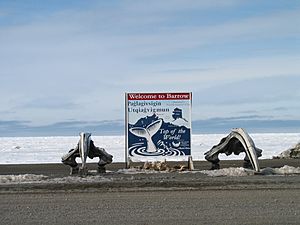
The area where Utqiagvik is located has been home to the Iñupiat people for over 1,500 years. The Iñupiat are an indigenous group of Inuit people.
The city's Iñupiaq name, Utqiaġvik, means "a place for gathering wild roots." It comes from the Iñupiat word utqiq. This word is also used for a plant called "Eskimo potato". European explorers first wrote down this name in 1853.
The city was formerly known as Barrow. This name came from Point Barrow. Non-native Alaskans found "Barrow" easier to say. Point Barrow was named in 1825 after Sir John Barrow, a British Navy official. A post office opened in 1901, making the name "Barrow" more common.
In 2016, people in the city voted to change the name back to Utqiaġvik. This change became official on December 1. City leaders said the name change helps support the Iñupiat language. It is also part of a process to honor indigenous culture.
Another Iñupiaq name for the area is Ukpiaġvik. This name means "the place where snowy owls are hunted." It comes from the word ukpik, which means "snowy owl".
History of Utqiagvik
Early History and Settlements

Archaeological sites show that the Iñupiat people lived around Utqiagvik as early as 500 AD. You can still see the remains of 16 sod houses from the Birnirk culture. These houses are about 800 years old. They are located on the shore of the Arctic Ocean. These old sites are at risk of being lost due to erosion.
British Navy officers came to this area to explore and map the Arctic coastline. The United States bought Alaska in 1867. In 1881, the United States Army set up a research station in Utqiagvik. This station studied weather and magnetism.
In 1888, a Presbyterian church was built by missionaries. This church is still used today. A whaling supply and rescue station was built in 1889. This is the oldest wood building in Utqiagvik. It is listed as a historic place. Later, it became a store and then a cafe.
From the 20th Century to Today
In 1901, a United States Post Office opened in the city.
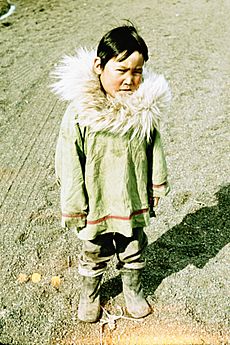
In 1935, the famous humorist Will Rogers and pilot Wiley Post stopped near Utqiagvik. Their plane crashed when they took off again, and both were killed. Two memorials are at the crash site. Another memorial is in Utqiagvik, where the airport was named the Wiley Post–Will Rogers Memorial Airport in their honor.
In 1940, the Iñupiat people formed their own government. It is called the Native Village of Barrow Iñupiat Traditional Government. They created rules for their community.
Utqiagvik became an official city in 1958, under the name Barrow. In 1965, natural gas lines were brought to the town. This replaced older ways of heating homes, like using whale blubber.
In 1971, the Alaska Native Claims Settlement Act was passed. This law gave land and money to Alaska Native groups. In 1972, the North Slope Borough was created. This borough used money from the settlement and oil to build important services. These services included water, electricity, roads, fire departments, and health and education facilities.
In 1986, the North Slope Borough started the North Slope Higher Education Center. It is now called Iḷisaġvik College. This college offers two-year degrees and focuses on Iñupiat culture. The Tuzzy Consortium Library is also in Utqiagvik. It serves the whole North Slope Borough and is part of Iḷisaġvik College.
In 1988, Utqiagvik gained worldwide attention. Three gray whales got trapped in the ice offshore. A rescue effort, called Operation Breakthrough, lasted two weeks. A Soviet icebreaker helped free two of the whales. This event was made into the movie Big Miracle in 2012.
Geography of Utqiagvik
Utqiagvik is about 1,300 miles south of the North Pole. It is a very northern place on Earth.
The city covers about 21 square miles. About 3 square miles of this area are covered by water. The land in Utqiagvik is mostly tundra. Tundra is a flat, treeless plain. It is formed over a layer of permafrost, which is ground that stays frozen all year. The permafrost here can be as deep as 1,300 feet.
Utqiagvik is divided into three main parts: south, central, and north. Residents call these Utqiagvik, Browerville, and NARL.
- The south part is the oldest and second largest. It is like the downtown area. Here you will find the Wiley Post-Will Rogers Memorial Airport, Barrow High School, restaurants, hotels, and the city hall.
- The central part is the largest and is called Browerville. This area has many homes and businesses. It includes the Tuzzy Consortium Library, the post office, Samuel Simmonds Memorial Hospital, and the Iñupiat Heritage Center.
- The north part is the smallest and most separate. It is known as NARL because it used to be a research lab. Now, Iḷisaġvik College is located here.
An ancient crater, called Avak, is located near Utqiagvik. It is about 5 miles wide.
Climate and Weather in Utqiagvik
Utqiagvik is about 330 miles north of the Arctic Circle. Its climate is very cold and dry. It is classified as a tundra climate. Winters are very dangerous due to cold and wind. Summers are cool, even at their warmest.
Utqiagvik has the lowest average temperatures of any city in Alaska. Temperatures stay below freezing from early October to late May. They are often below 0°F from December to March. Freezing temperatures and snow can happen in any month of the year.
Utqiagvik gets very little precipitation, like a desert. It averages less than 6 inches of "rainfall equivalent" per year. This includes about 46 inches of snow each year. Snowfall has increased in recent years. The first lasting snow usually falls in the first week of October. October is often the snowiest month.
When the sun sets on November 18, it stays below the horizon until January 23. This is called polar night and lasts about 66 days. During this time, there are only a few hours of twilight each day. On the shortest day of the year, around December 21, twilight lasts only about 3 hours.
Serious cold weather usually starts in January. February is generally the coldest month. By March 1, the sun is up for 9 hours. Starting March 23, there is no more full night, only daylight and twilight. This lasts until the midnight sun begins in May.
The sun stays above the horizon for 83 days, from about May 10 to August 1. This is the midnight sun. July is the warmest month, with an average temperature of about 41.7°F. The highest temperature ever recorded was 79°F on July 13, 1993. The lowest was -56°F on February 3, 1924.
Utqiagvik is also one of the cloudiest places on Earth. It is completely cloudy more than 50% of the year. Fog is common, especially in summer. During winter, when it's very cold, ice fog is common. Winds average about 12 miles per hour and usually come from the east.
How Global Warming Affects Utqiagvik
The Arctic region is warming faster than the rest of the world. This causes big changes for people in Utqiagvik. Thinner sea ice makes it harder for whalers to hunt bowhead whales. The habitat for caribou is also changing.
The thawing ground threatens homes and other buildings. The city's water, power, and roads are at risk. The shoreline is eroding quickly, meaning the land is washing away. Scientists believe that rising sea levels will eventually threaten Utqiagvik's current location. Since 1976, Utqiagvik has warmed by more than 11°F.
Population and People
| Historical population | |||
|---|---|---|---|
| Census | Pop. | %± | |
| 1880 | 225 | — | |
| 1890 | 246 | 9.3% | |
| 1900 | 314 | 27.6% | |
| 1910 | 446 | 42.0% | |
| 1920 | 322 | −27.8% | |
| 1930 | 330 | 2.5% | |
| 1940 | 363 | 10.0% | |
| 1950 | 951 | 162.0% | |
| 1960 | 1,314 | 38.2% | |
| 1970 | 2,104 | 60.1% | |
| 1980 | 2,207 | 4.9% | |
| 1990 | 3,469 | 57.2% | |
| 2000 | 4,581 | 32.1% | |
| 2010 | 4,212 | −8.1% | |
| 2020 | 4,927 | 17.0% | |
| U.S. Decennial Census | |||
The first census record for the area was in 1880. It was called "Ootiwakh," and all 225 residents were Inuit. In 1890, the area was called "Cape Smythe Settlements." It included different camps and whaling stations.
From 1910 to 2010, the community was known as Barrow in the census. In 1959, it officially became a city. The name Utqiagvik was adopted in 2016 and used in the 2020 census.
In 2010, about 60.5% of the people in Utqiagvik were Alaskan Native. About 16.2% were White, and 8.9% were Asian. Many people were also from two or more races.
In 2000, the average household had 3.35 people. The average family had 4.80 people. About 27.7% of the population was under 18 years old. The median age was 29 years.
As of 2022, the city's website states that about 61% of Utqiagvik's 4,429 residents are Iñupiat Eskimo.
Economy and Jobs
Utqiagvik is the main economic center for the North Slope Borough. The city government is the biggest employer. Many businesses support oil field operations in the area. State and federal government agencies also provide jobs.
Tourism is growing, especially because of the midnight sun. Local arts and crafts also provide some income. Food is expensive to transport to Utqiagvik. Because of this, many residents still rely on traditional food sources. They hunt whales, seals, polar bears, walruses, and caribou. They also fish in nearby rivers and lakes.
Utqiagvik is the headquarters of the Arctic Slope Regional Corporation. This corporation was set up in 1971 to manage money and invest in development for the local people.
Arts and Culture
Special Events and Celebrations
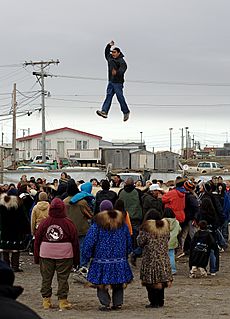
- Kivgiq, or the Messenger Feast, is a big event. It is usually held every two or three years in late January or early February. People from all over the Arctic Circle come to this international event.
- Piuraagiaqta, the Spring Festival, celebrates making a path in the ice for whaling boats. It happens in mid-April and includes many outdoor activities.
- Nalukataq, the Blanket Toss Celebration, is held in June. It celebrates each successful spring whale hunt.
- On July 4, Independence Day, Utqiagvik holds Eskimo games. These include the two-foot high kick and ear pull. Winners can go on to compete at the World Eskimo Indian Olympics.
- Whaling usually takes place in the second week of October.
- Qitik, or Eskimo Games, are also known as Christmas Games. They are held from December 26 to January 1.
Sports in Utqiagvik
Football
On August 19, 2006, the Whalers, the football team from Barrow High School, played their first official game. It was the first football game ever played in the Arctic. They won their first game two weeks later. The team celebrated by jumping into the Arctic Ocean.
In 2007, the Whalers played on a new artificial-turf field. This game was the first live Internet broadcast of a sports event from north of the Arctic Circle.
The team has a good record of 33 wins and 24 losses. In 2017, the Barrow High School football team won its first state championship. They beat the Homer Mariners 20–14.
Basketball
In 2015, the Barrow High School boys' basketball team won the Alaska Class 3A State Championship. They beat Monroe Catholic 50–40. A talented player named Kamaka Hepa led the team. He was considered one of the top basketball recruits in the country.
The Whalers' boys' basketball team finished the 2014–2015 season with 24 wins and 3 losses. This was the best win percentage in the school's history. The Barrow High School girls' team also won a big tournament in 2015.
Education in Utqiagvik
Utqiagvik is part of the North Slope Borough School District. The schools in the city are Ipalook Elementary School, Hopson Middle School, Barrow High School, and the Kiita Learning Community.
Iḷisaġvik College is a two-year college located in Utqiagvik. It is the only tribal college in Alaska. The college offers different certificates and associate's degrees. These include studies in accounting, business, construction, and Iñupiaq studies. It also offers a bachelor's degree in business administration. The college helps adults prepare for the GED test. Students can also go to the University of Alaska Fairbanks or other colleges.
Media and Communication
Newspaper
The Arctic Sounder is a newspaper published every week. It covers news for the North Slope Borough, including Utqiagvik. It also covers news for the Northwest Arctic Borough.
Radio
KBRW (AM)/KBRW-FM broadcasts in Utqiagvik. You can listen on 680 kHz AM and 91.9 MHz FM. KBRW also broadcasts to other villages in the North Slope Borough.
City Infrastructure

Transportation
The roads in Utqiagvik are not paved. This is because of the permafrost. There are no roads that connect the city to the rest of Alaska.
Utqiagvik has passenger jet service from Alaska Airlines. Flights go to and from Anchorage and Fairbanks at the Wiley Post–Will Rogers Memorial Airport. Freight arrives by air cargo all year. Large marine barges also bring freight during the summer.
Utqiagvik is a transportation hub for the Arctic coastal villages of the North Slope Borough. Daily flights bring mail, cargo, and passengers. These flights connect to smaller planes that serve other villages. The town also has several taxi services.
Notable People from Utqiagvik
- Harry Brower Sr. (1924–1992), a whaling captain and community leader.
- Kamaka Hepa (born 2000), a college basketball player.
- Eben Hopson (1922–1980), a former member of the Alaska Senate.
- Morgan Kibby (born 1984), an actress, singer, and songwriter.
- Edna Ahgeak MacLean (born 1944), a linguist and educator.
- Sadie Neakok (1916–2004), the first female magistrate in Alaska.
- John Nusunginya (1927–1981), a former member of the Alaska House of Representatives.
- Josiah Patkotak (born 1994), a former member of the Alaska House of Representatives and mayor of the North Slope Borough.
- Tara Sweeney (born 1973), a former Assistant Secretary for Native American affairs.
Images for kids
See also
 In Spanish: Utqiaġvik para niños
In Spanish: Utqiaġvik para niños





